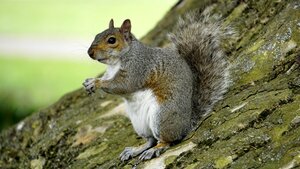
Climate is most important factor in where mammals choose to live, study finds
While human activity has had a massive effect on the natural world, a new study from...

New clam species discovered in South Africa's kelp forest
A new study sheds light on the unexplored diversity of galeommatoidean bivalves, a little-known group of...

Increased demand for metals and minerals needed for clean energy transition puts 4,000+ species at risk, finds study
New research has found that 4,642 species of vertebrates are threatened by mineral extraction around the...

Scientists figure out why there are so many colorful birds in the tropics and how these colors spread over time
The color palette of the birds you see out your window depends on where you live....

Study reveals close host–symbiont interactions in deep-sea chemosynthetic tubeworm
Vestimentiferan tubeworms, unique deep-sea dwellers lacking a digestive system, rely on a symbiotic partnership with sulfide-oxidizing...

New Zealand's flightless birds are retreating to moa refuges
Researchers have found New Zealand's endangered flightless birds are seeking refuge in the locations where six...

Female whale shark with satellite transmitter for record-breaking four years shows consistent migrations
A team of researchers at the University of Rhode Island and Nova Southeastern University in Florida...

Research shows the ocean is becoming too loud for oysters
Baby oysters rely on natural acoustic cues to settle in specific environments, but new research from...

Biologists discover human-infecting parasite produces sterile soldiers like ants and termites
New research from scientists at UC San Diego's Scripps Institution of Oceanography finds a tiny freshwater...

Researchers record first-ever images and data of a shark being struck by a boat
Hours after tagging an endangered basking shark off the coast of Ireland in April, researchers captured...

Butterflies accumulate enough static electricity to attract pollen without contact, research finds
Butterflies and moths collect so much static electricity while in flight, that pollen grains from flowers...

The unintended consequences of success against malaria
For decades, insecticide-treated bed nets and indoor insecticide spraying regimens have been important—and widely successful—treatments against...

One elephant can sustain more than 2 million dung beetles in east African savannas, study finds
How many dung beetles are there in East Africa? That question inspired a research project more...

Natural drylands grossly under-protected: Study predicts major threats due to human land-use conversion
Drylands cover about 42% of the Earth's land surface and are increasingly threatened by human land-use...

Mathematical models used to calculate speed of disease spread in early ocean travel
Two scientists at the University of California, Los Angeles, have developed a way to calculate the...

Researchers elucidate biogeographic context of human evolution in East African Rift System
Ignacio A. Lazagabaster, a Ramón y Cajal researcher at the Centro Nacional de Investigación sobre la...

Heat-sensitive trees moving uphill due to rising temperatures, study finds
Trees in the Brazilian Atlantic Forest are migrating in search of more favorable temperatures, with species...

Cocaine found in muscle and liver of sharpnose sharks off coast of Rio de Janeiro
A team of marine biologists and ecotoxicologists affiliated with several institutions in Brazil has found cocaine...

Chimpanzees gesture back and forth quickly like in human conversations, researchers find
When people are having a conversation, they rapidly take turns speaking and sometimes even interrupt. Now,...

Eco-friendly treatment saves squid eggs from newfound parasite
Raising squid in aquaculture has been a challenge that researchers have tried to address for many...

Biologists discover male elephants use infrasonic rumbles to signal 'let's go'
Bull elephants gather in the evening coolness to drink. After a spell, a senior male lifts...

Global study demonstrates benefit of marine protected areas to recreational fisheries
Marine Protected Areas (MPAs) are having a positive spillover effect, producing more "trophy-size" fish just outside...

Killifish can adjust their egg-laying habits in response to predators, study shows
Some species of fish can change their egg-laying habits in response to predators in the area...

Giant millipede was lost to science for 126 years: It's just been found in Madagascar
When a new species is discovered in the depths of the rainforest or on top of...

Genome study informs restoration of American chestnut tree
Native trees adapt to the climate and environmental conditions of their area to survive. Researchers in...

Of ants and trees: 'Evolutionary déjà vu' in the tropical rainforest
Ants are famous for their regimented and complex social behaviors. In the tropics, they are also...

Tropical plant species are as threatened by climate change as widely feared, study confirms
Brown University biologists who set out to better understand the effects of climate change on plant...

Fish biodiversity found to benefit nutrition, particularly for lower income people
Households caught and consumed a far more diverse array of fish than they sold at market,...

Fish barriers may aid baby corals in reef recovery
Scientists from the Australian Institute of Marine Science (AIMS) and James Cook University (JCU) have designed...

The most endangered fish are the least studied, scientists find
The most threatened reef fish are also the most overlooked by scientists and the general public....

Crown-of-thorns starfish larvae feast on toxic cyanobacteria, study finds
Researchers have uncovered an under-the-sea phenomenon where coral-destroying crown-of-thorns starfish larvae have been feasting on blue-green...

Lice cause significant harm to cage-free poultry, study finds
Lice have been found feeding on the skin and blood of free-range chickens, which are infected...

Research tracks 66 million years of mammalian diversity
When trying to understand the present, it's helpful to look to history. New research from the...

Logged forests can still have ecological value—if not pushed too far
Researchers have analyzed data from 127 studies to reveal 'thresholds' for when logged rainforests lose the...

Japanese honeybees slap nest-invading ants with their wings to knock them away
A trio of environmental specialists at the National Institute for Environmental Studies, in Japan, has found...

Study shows frogs can quickly increase their tolerance to pesticides
Although there is a large body of research on pests evolving tolerances for the pesticides meant...

Scientists use machine learning to predict diversity of tree species in forests
A collaborative team of researchers led by Ben Weinstein of the University of Florida, Oregon, US,...

Online sales of a wild bat sold as décor threaten species
A fiery orange bat, its wings folded and tiny teeth forever bared on its fuzzy face,...

Scientists unravel transition of survival strategies in grape family
In a study published in Nature Plants, scientists have identified the Eocene, Oligocene, and Miocene boundaries...

World's rarest whale may have washed up on New Zealand beach, possibly shedding clues on species
Spade-toothed whales are the world's rarest, with no live sightings ever recorded. No one knows how...

New concept explains how tiny particles navigate water layers, with implications for marine conservation
A new UBC study published recently in Proceedings of the National Academy of Science has unveiled...

Wildlife tracking technology that adheres to fur delivers promising results from trials on wild polar bears
Studying polar bears just became a lot easier with new "burr on fur" trackers which confirmed...

Study unveils complexity of zoonotic transmission chains
Researchers from the Complexity Science Hub and the University of Veterinary Medicine Vienna have dissected the...

Hatcheries can boost wild salmon numbers but reduce diversity, research shows
The ability of salmon hatcheries to increase wild salmon abundance may come at the cost of...

History shows that humans are good for biodiversity… sometimes
Humans have been an important driver of vegetation change over thousands of years, and, in some...

Social contagion research explores how ant colonies regulate group behaviors
In the world of social creatures, from humans to ants, the spread of behaviors through a...

Study of colorful crayfish challenges theories of bright coloration as adapted phenotype
A pair of biologists, one with West Liberty University, the other with Arizona State University, both...

A stealth fungus has decimated North American bats, but scientists may be a step closer to treating white-nose syndrome
An invasive fungus that colonizes the skin of hibernating bats with deadly consequences is a stealthy...

Introducing co-cultures: When co-habiting animal species share culture
Cooperative hunting, resource sharing, and using the same signals to communicate the same information—these are all...

Scientists find a natural quicksand trap dated to more than one million years ago in the 'elephant graveyard' of Orce
Scientists at the University of Malaga have shown, in an unprecedented way, how the so-called "elephant...



